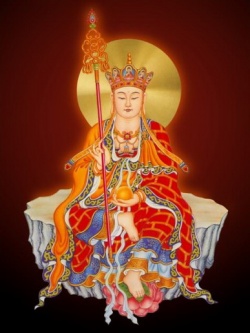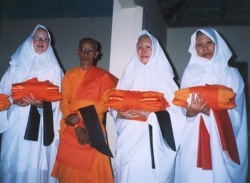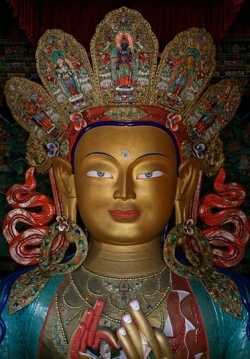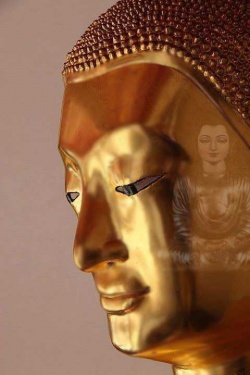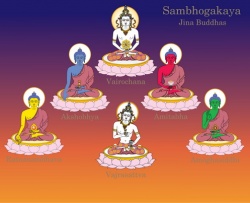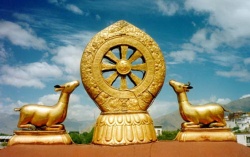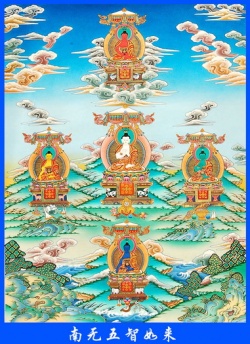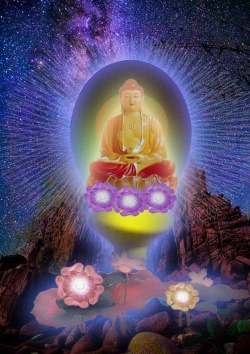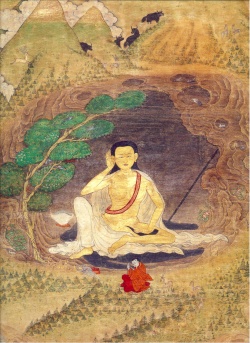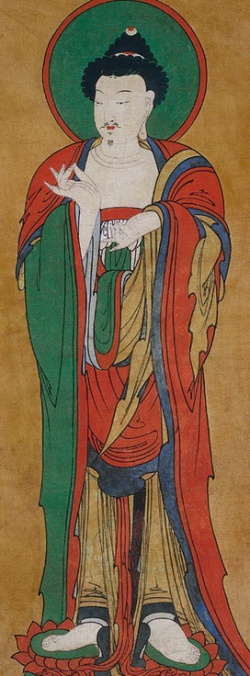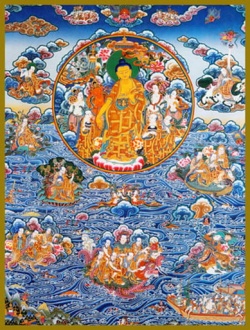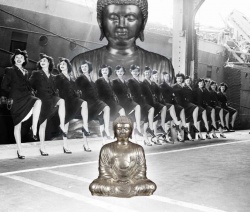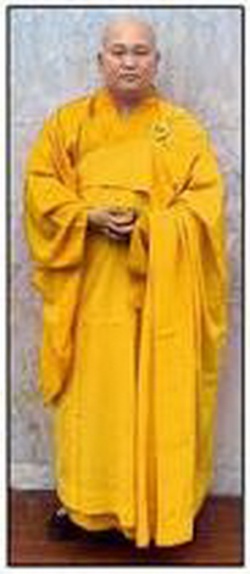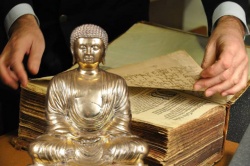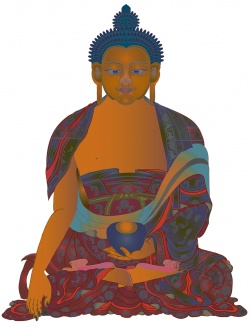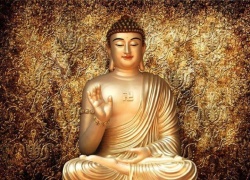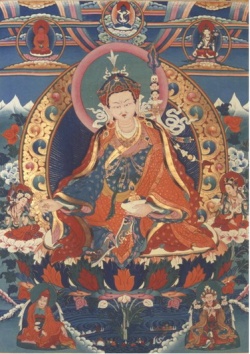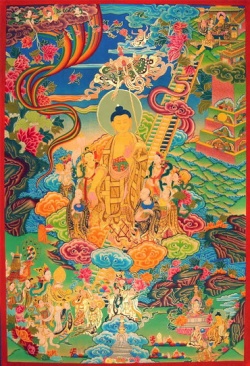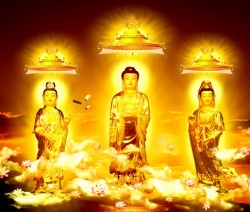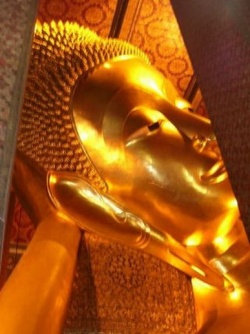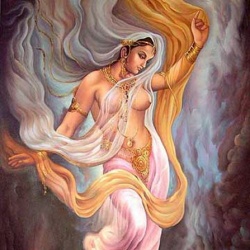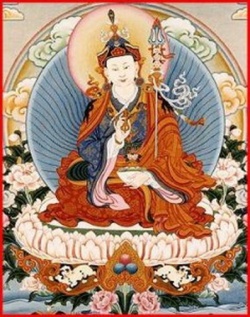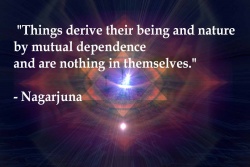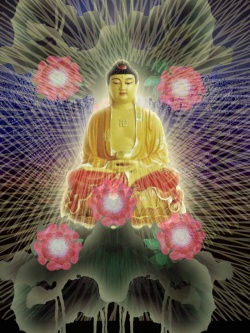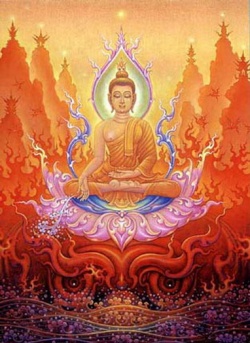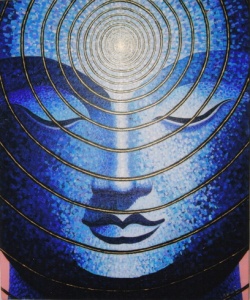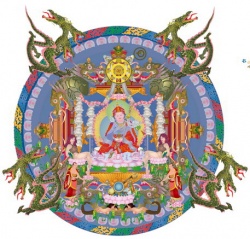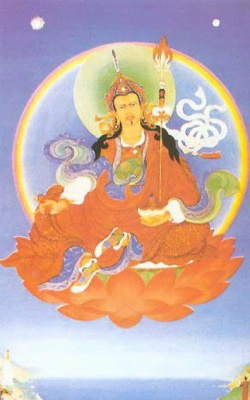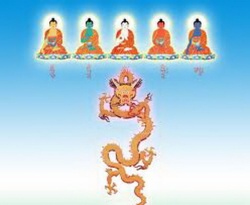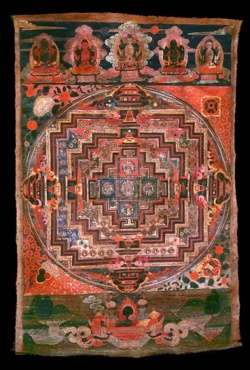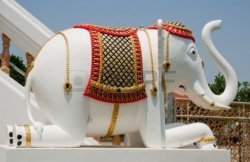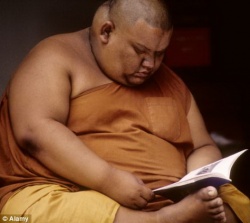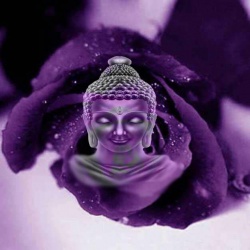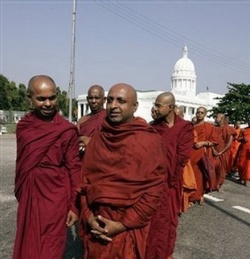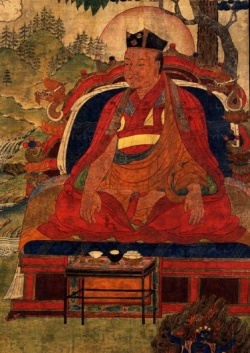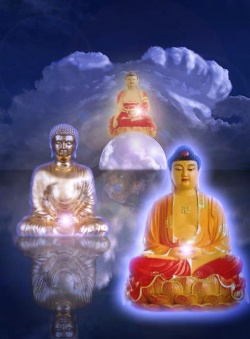Nyāya - The School of Logicians
Nyāya - The School of Logicians
The Nyāya is the science of logic, and provides the only sound methodology of philosophical inquiry into the nature of knowledge and the objects of knowledge.
It is the means to obtain Right Knowledge (pramā) about the Self and to discover the purpose of life.
The only way to impart our experience to others and to elucidate their implications for the rest of our life and defend their validity against hostile criticism is by means of logic.
The term Nyāya in Sanskrit signifies "going into a subject," —an analytical investigation of the subject through the process of logical reasoning.
Vātsyāyana, the classic commentator on the Nyāya-Sūtra, defines it as:
"a critical examination of the objects of knowledge by means of the canons of logical proof."
The Nyāya is also called Tarka-vidyā, "science of reasoning," or Vāda-vidyā "science of discussion."'
The founder of the Nyāya was Gautama (Gotama) who is frequently-referred to in the literature as Akṣa-pāda, “Eye-footed," and Dīrgha-tapas, "Long-penance."
In ancient India it was customary to give people nicknames which gave a descriptive characterisation of the individual.
Gautama probably received these names from his habit of performing long penances during his periods of study and from the fact that he was customarily seen with his eyes directed toward his feet when walking, (probably due to his deep reflection while strolling)
There is considerable argument about the exact date of Gautama but authorities place him about 550 BC., making him almost a contemporary of Buddha.
According to tradition, Gautama, the founder of the Nyāya, was born in the village of Gautama-sthāna, and each year a fair is held in this village in his honour on the 9th day of the lunar month of Caitra (March-April).
The village is located 28 miles north east of Darbhaṅga.
Before Gautama, the principles of the Nyāya existed as an unsorted body of philosophical thought, concerning things that can be known and on the means of acquiring such knowledge.
Gautama merely formulated the generally accepted principles of the time.
The Problem
All systems of Indian philosophy begin with the problem of suffering – duḥkha.
The goal of the Nyāya is to enable us to attain the highest goal of life which is Liberation from duḥkha and the attendant cycle of births and deaths — mokṣa, variously known as ‘release’, ‘freedom’, ‘emancipation’ or nirvāṇa –the state of non-return to birth/death.
According to nyāyikas the world presents itself us as a chain of consequences which needs to be broken in order to attain Liberation from suffering.
Misapprehension ajñāna
=> imbalance doṣa
=> activity karma
=> rebirth janma
=> suffering duḥkha
Misapprehension — the inability to see things as they really are; the superimposition of false ideas and concepts upon reality — identification of the Self with the mind/body complex.
Imbalance —ego-centrism, and the creation of a vast network of false identities and ideologies in order to bolster and maintain the ego —activated by the three dynamic forces of attraction, aversion and delusion.
Karma —activity in accordance with this false view of ourselves and the world; designed to perpetuate our transient selves and to give some meaning to our lives.
All actions involving other beings have 3 possible outcomes: negative (cause suffering), positive (cause joy), or neutral.
Negative and positive acts result in consequences which are experienced either now or later.
Rebirth —in order to actualise the karma that we have created for good or bad.
Suffering —disease, dissatisfaction, unhappiness, stress, depression etc.
The Solution
1. The way to break this chain is to obtain insight and wisdom (jñāna).
2. Wisdom dissolves the delusive identification of the Self with the mind-body complex.
3. The doṣas causing us to like and dislike a thing will no longer exist. When this disappears, there will no longer be any desire which is the stimulus for all goal orientated activity.
4. Cessation from action will break the eternal bond of karma which will then free us from rebirth; the cause of all sorrow and suffering, and enable us to achieve the supreme end of life mokṣa.
5. This goal can be attained by thoroughly studying and understanding the 4 topics presented in the Nyāya sūtras, namely:
(1) The thing to be avoided (i.e., duḥkha)
(2) Its cause (i.e., desire, attachment and ignorance)
(3) Its solution i.e. absolute avoidance
(4) The means of such avoidance (i.e., true knowledge of things as they really are)
The Nyāya examines the logic and coherence of philosophical or religious statements, and by comparing such statements with other widely-held beliefs about life, assess the appropriateness of accepting them as true.
What is rational?
— The rational process is one in which conclusion are drawn from premises by a sequel of mental steps which can be followed, verified, and which others (provided they understand the meaning of the words used) would accept as being true —true for everyone, not just for that particular individual).
The study of Nyāya enables us to discern the true from the false, and ensures the avoidance of false teachings and beliefs while knowledge matures into the dawning of enlightenment.
Today, as was the case centuries ago we are confronted by many gurus with many teachings. The conflicting doctrines of each new sect and teacher raises doubts as to which is the right path. The spiritual aspirant is confronted with the same problem of trying to discern the true from the false.
The teachings of the Nyāya System are intended to give us a rational basis for knowing the Truth.
The Nyāya deals with critical inquiry. It explores all traditional beliefs and argues vigorously against all superstition, prejudiced and irrational beliefs.
Wherever there is constructive thinking directed at acquiring real understanding there is a need for Logic.
This desire for seeking truth is innate in human nature and logic enables us to accomplish constructive rational thinking.
The purpose of logic is the realisation of the Self by providing the means of studying, listening, reflecting and judging. This culminates in the removal of doubt and leads to mature wisdom, or to confirm that which has been passed down through tradition.
It is only by thorough examination of the sources and expressions can Truth be ascertained. Therefore all knowledge and traditional teaching offered to us, as well as our experiences must be submitted to critical inquiry.
The chief concern of the Nyāya methodology is the means of knowing and not the nature of knowledge.
1. It investigates the objects of our present perception, not their origination.
2. It lays down the rules of syllogistic reasoning for the purpose of examining the objects of perceptions.
3. It is the operative cause of Right knowledge and classifies the different ways in which knowledge is acquired.
Methodology
The logical method of ascertaining the Truth is through the application of the 16 categories of Logic, called Padārthas or topics these are:
1. Means of right knowledge pramāṇa
2. Object of right knowledge prameya
3. Doubt Saṁśaya
4. Motive prayojana
5. Illustrations dṛṣṭānta
6. Demonstrated Truth siddhānta
7. Factors of Reasoning —syllogism avayava
8. Reasoning and confutation tarka
9. Ascertainment nirṇaya
10. Discussion vāda
11. Disputation jalpa
12. Cavil or objecting vitaṇḍā
13. Fallacious Reasoning hetvābhāsa
14. Casuistry (unfair reasoning) chala
15. Futile Rejoinder jāti
16. Clinchers nigraha-sthāna
The first two are the most important. The first nine deal more strictly with logic, while the last seven have the function of preventing and mitigating error.
The process of Nyāya consists of three stages:—
=> Statement
=> definition
=>examination
1. THE MEANS OF RIGHT KNOWLEDGE
Pramāṇa
Definition of Right Knowledge (pramā)
Yathāvasthita vyavahārāṇuguṇa jñānam pramā
Right knowledge is that which reveals a thing as it actually is and is pragmatic.
Knowledge is said to be true when there is –
1. Coherence
2. Correspondence
3. Consequence or Utility
Coherence —The statement must be logical and consistent.
Correspondence —the knowledge must correspond to the actual nature of the object as it is. (tadvati-tat-prakāraka)
Consequence — Utility —our practical activities in relation to the object are successful. (pravṛtti-samārthya).In other words we can do something with it.
Right knowledge (pramā) reveals a thing as it really is and leads to successful utilisation thereof.
False knowledge does not correspond to reality and any activity directed thereby results in failure and disappointment.
N.B. ‘Right’ or ‘valid’ knowledge in the Indian context is somewhat individualized —
for example; knowledge of quantum particles is useful for a scientist engaged in that type of research but not useful for the common person, as nothing can be done with this knowledge —it may certainly be true but it is not valid in terms of practical outcomes of daily life.
It may be possible to count the number of grains of sand on a beach and this may have some scientific application, but the knowledge, albeit true is unusable for all practical purposes and therefore said to be “invalid” or more properly “irrelevant”.
According to Nyāya, there are 4 means whereby we obtain information:
1. Empirical knowledge, Sense perception/experience pratyakṣa
2. Discursive reasoning, inference anumāna
3. Analogy upamāna
4. Verbal testimony of a trustworthy source. śabda
Each school of Indian thought has its own theory of the Means to obtain Right knowledge:
Cārvākas: Perception pratyakṣa
Mīmāṁsakas: Verbal Testimony śabda
Vaiśeṣika & Buddhists: perception pratyakṣa & inference anumāna
Sānkhyas: perception pratyakṣa, inference anumāna & verbal testimony śabda
Naiyāyikas: perception pratyakṣa, inference anumāna comparison upamāna verbal testimony śabda
Prabhākaras: perception pratyakṣa, inference anumāna comparison upamāna verbal testimony śabda presumption arthāpatti,
Bhāṭṭas & Vedāṅtins perception pratyakṣa, inference anumāna comparison upamāna verbal testimony śabda presumption arthāpatti, non-existence abhāva
Paurāṇikas: perception pratyakṣa, inference anumāna comparison upamāna verbal testimony śabda presumption arthāpatti, non-existence abhāva probability [saṁbhava] and tradition aitihya
Presumption arthāpatti —is the deduction of one thing from the assertion of another thing,
e.g., from the assertion that —'unless there is a cloud, there is no rain,' we presume that -'there is rain, if there is cloud.'
Non-existence abhāva —is the deduction of the existence of one of two contradictory things from the non-existence of the other;
e.g., the absence of the sun establishes the presence of the stars.
Probability sambhava —consists in cognising the existence of a thing from that of another thing in which it is included.
Tradition aitihya —received wisdom without any verification of the source from which it first originated.
According to Nyāya these four additional means:
presumption, non-existence and probability are included in inference, and tradition is included in Verbal Testimony.
They are not considered as independent means of right knowledge because they do not form a separate category, and there is no need to consider them separately.
1:1 Perception (pratyakṣa)
The knowledge which arises from the contact of a sense with its object, and which is determinate, unnameable and consistent.
Sense perception is of two kinds:-
1. Indeterminate (nirvikalpaka) or abstract —general, non-specific.
2. Determinate (savikalpaka) or concrete —specific.
"Indeterminate" knowledge is vague and non-specific —
i.e. not being able to tell the difference between smoke or dust seen at a distance. Or not being able to distinguish between a snake and a rope in dim light.
“Determinate” knowledge is that which is clear and differentiated from other things.
The "unnameable" brings to our attention the fact that the name of an object has no connection with the knowledge of it derived through our direct perception. We know the object but may not know the name of the object.
The "consistent" means that we can actualise the knowledge, i.e. the perception of water in a mirage which is an illusion is inconsistent with what we know and can use.
Perceptual knowledge must be real, actual, suitable, specific, particular and not vague, visionary or general.
1:2 Inference (Anumāna)
That knowledge which is deduced from prior perception.
Anumāna is based upon a well-known or observed connection (concomitance) between 2 things (cause and effect).
E.g. clouds + rain, rain + harvest, smoke + fire, insult + anger, love + attachment, etc.
There are 3 types of anumāna or inference;–
1. It may be a priori, —from cause to effect; (pūrvavat)
e.g., on seeing clouds, one infers that it is going to rain;
2. or it may be a posteriori, —from effect to cause; (śeṣavat)
e.g., on seeing a river swollen, one infers that there has been rain fall.
3. It may also be what is termed 'commonly seen,'(samānyatodṛṣṭa) which is knowledge of one thing derived from the perception of another thing with which it is commonly seen;
e.g., on seeing rain, one infers that there are clouds.
Another example of this sort is the movement of the moon which is inferred on the basis of its changing position in the sky, although the movement of the moon is not perceived directly by the senses.
1:3 Analogy (Upamāna)
[
Knowledge of a thing derived from its similarity to another thing already well known.
For example, one is told that a water buffalo resembles a big black cow;
One then travels to a place where the water buffalo lives, and on seeing an animal resembling a big black cow, one concludes that it must be a water-buffalo.
Analogy has been regarded in Nyāya as an independent means of Right Knowledge because it brings about a right cognition that cannot be achieved through either sense-perception or inference.
1:4 Verbal Testimony (śabda/ āgama/āpta-vākya)
The instructive assertion of a reliable person (āpta), that is, one who is possessed of true knowledge and is truthful.
This instruction may be about perceptible things or about intangible realities.
The first can be verified, but one must depend upon inference (anumāna) to ascertain the truth of the latter.
The “reliable” person (āpta) must be someone who is:—
1. Free from prejudices or bias
2. Has no self-interest in the outcomes of instruction.
3. Is recognised by other authorities as trustworthy
For example, the ‘scientists’ who provide a tobacco company with ‘evidence’ that tobacco is not injurious to health are not reliable persons, because they are being funded by the tobacco company and their results are favourable to a product which has been proven beyond reasonable doubt to be harmful to human health and the majority of their colleagues denounce them.
=> Perception is concerned chiefly with the present;
=> Inference deals with the past, present, and future;
=> Comparison is an instrument of perception, enabling us to know a named object.
=> Verbal testimony reveals knowledge about things which we cannot know by ourselves.
=> It is by means of these four sources of right knowledge that the goals of humankind are accomplished.
2. 1 THE TOPICS OF RIGHT KNOWLEDGE
Prameya
The body śarīra | Self ātman | Senses indriya | Experiences artha| Intelligence buddhi | Intellect manas| Activity pravṛtti | Imbalances doṣa Consequence phala | Suffering duḥkha| Re-birth pratyabhāva | Liberation apavarga
There are many things that might be regarded as topics of right knowledge, but these 12 are especially significant:
because the true knowledge about them will dispel all delusions and lead to freedom from suffering; while false knowledge concerning these topics perpetuates rebirth and suffering.
Nyāya only establishes these principles on a rational basis but does not attempt to dilate upon them.
Nyāya does not attempt to explain all that is known about these several topics that is left for the more speculative systems of philosophy.
The indications of the existence of the Self (ātman):
attraction (rāga) | aversion (dveṣa)
pleasure (sukha) | pain (duḥkha)
knowledge (jñāna) | striving(prayatna)
=> These are experiences which are common to all sentient beings.
=> There is obviously a subject that experiences them and that subject is called a Self or ātman.
=> Since the ātman is one of the intangible realities it cannot be apprehended through the senses; the Self is self-evident to all of us, none of us doubt our own existence.
=> The ātman is the subject of these phenomena and is something distinct from the body and the mind. But it cannot be demonstrated by sense-perception as it is the Subject.
=> It’s existence is established through anumāna or inference and from śabda —scriptural testimony.
2:2. The body (śarīra)
The body is that which is the locus of motion (ceṣṭa), of the senses (iṅdriyas) and of their effects/experiences (arthas) of pleasure and pain.
=> The body is the field of the Ātman’s experiences as it strives to attain what is pleasurable and avoid what is un-pleasurable.
=> All these activities are actualised through the 10 senses, the instruments through which the ātman receives stimuli from the external world and through which it reacts to those stimuli.
=> The receptors of pleasure and pain lie within the brain which mediates the experiences thereof. The śarīra includes both the physical body and the brain and hence is usually referred to as the mind/body complex.
2:3. The Senses & 2:4. Their Experiences
Senses (Iṅdriyas) -> Elements (Bhūtas) -> Experiences (Arthas)
smell — (ghrāṇa) | Earth —(pṛthivī) | odour — (gaṅdha)
taste — (rasana) | water — (apas), | flavour — (rasa)
vision — (cakṣus) | fire — (tejas) | colour — (rūpa)
touch — (tvak) | air — (vāyu) | sensation — (sparśa)
hearing — (śrotra) | ether — (ākāśa ) | sound — (śabda)
The senses and their objects provide five varieties of perception yielding special kinds of knowledge according to the objects which they reveal.
There are six categories which constitute “the field” of the senses these are:—
1. Substance —is defined as that which is the material cause or constituent cause of a thing, or that which is the substratum of “qualities”.
According to Nyāya, there are 9 substances: —
earth (pṛthivī), water (ap), light (tejas), air (vāyu), gravity (dig), space (ākāśa), time (kāla), Self (ātman) and Mind (manas).
2. Quality —that which has general characteristics, or, the general attributes of a substance.
All the afore mentioned substances have qualities. These are 24 in number and are:
colour, taste, odour, touch, number, dimension, separateness, conjunction & disjunction, nearness & remoteness (both space and time), heaviness, fluidity, viscosity (smoothness of water), sound, knowledge, pleasure (gratification), suffering, desire (attachment), aversion, effort, merit & demerit and faculty (velocity, impression and elasticity).
3. Actions —upwards, downwards, horizontal movement, contracting and expanding.
4. Generality — all the known objects although different from one another are still substance. Their being substance is the higher generalization.
But these objects can be further divided into different classes, each class differing from the others but having an individual or lower generality.
5. Individuality — all matter is composed of atoms and each atom is an individual, therefore there are an infinite number of individuals.
6. Inherence.— this category refers to the intimate relationship that exists between a substance and its attributes or qualities, between atoms and their compounds, between the whole and its parts, between substance and its modifications.
=> Non-existence —this is a category which is included by some teachers of Nyāya
2:5. Intelligence; Buddhi
The ability of forming ideas and general notions, retaining conceptions and the faculty of the mind to discern, judge, comprehend, apprehend, and understand the meaning of right knowledge.
It is that mental power which enables one to reflect upon the teachings and to contemplate the Self.
2:6. Mind Manas
The capacity for reflection, inference, testimony, doubt, humour, dream, cognition, conjecture, memory, desire, and feeling of pleasure and pain.
In contrast with the faculty of intelligence; the intellect (buddhi) seeks factual knowledge which is worldly, while the Mind (manas) aims at wisdom which is divine.
2:7. Extrovert Activity (Pravṛtti)
That which sets the mind, body, and voice in motion, for good or bad.
It is the effect of these extroverted actions, stimulated by craving arising from false knowledge, which holds one in bondage to the cycle of suffering and saṃsāra
2:8. Imbalances (Doṣa) —The initiating causes of all action.
Fault => Manifestation
Attraction rāga => lust, greed, craving, selfishness, longing, and covetousness;
Aversion dveṣa => anger, envy, jealousy, and implacability
Delusion [abhiniveṣa] => Clutching, clinging, grasping, attachment
=> The mark of attraction is attachment;
=> The mark of aversion, is the lack of forbearance;
=> The mark of delusion, is misapprehension.
The worst of these is delusion because it gives rise to further attraction and aversion, which make one forget that there is nothing in actual fact which is agreeable or disagreeable to the ātman; therefore, there is no reason to like or dislike objects.
The reason for the appearance of the doṣas is due to the incapacity to distinguish the part from the whole, that is, the real from the unreal.
e.g., the beautiful body provokes lust, while the sight of blood repels. And so it is with everything throughout nature; there is the twofold aspect, the real and the unreal. Because of this false conception of the true nature of things, desires arise which in turn, stimulate us to action.
Here it must be remembered that the hatred of pain is none the less hatred; and until all such reactions are removed by true knowledge, one will remain attached to the illusory world of name nāma —mind and form rūpa —body.
Self-realisation ātma-bodha is acquired by constant study and reflection on the Dharma.
In this way wisdom can be matured until all doubt has been removed, and the mind will then awaken to the latent potential lying within.
We are all in essence enlightened beings —we only don’t know it yet!
2:9. Consequence (phala)
Consequence is the outcome of activity.
Every activity has an outcome which may take the form of either pleasure (sukha) or pain (duḥkha), depending upon the nature of its cause.
It is also twofold in that it gives pleasure or pain to another being or gives pleasure of pain to the actor.
The effect is also of two kinds; that which appears immediately as seen in practical projects, or that which appears after a lapse of time as seen in the planting of seed by a farmer.
The same principles operate in the ethical realm.
The fruit of right conduct in this world may appear as companionship (sahatva), progeny (prajā) and wealth (vittam), which are the three sources of worldly joy.
2:10. Suffering (duḥkha)
An impediment that hinders the progress of the Self.
=> The body is said to be the abode of suffering duḥkha-ālaya;
=> The senses are the instruments whereby we experience suffering,
=> The intellect is the agent of suffering;
=> Birth, then, is association with suffering; therefore, life is a passing experience of sorrow and suffering.
Pleasure is but an interval in this process, a mere distraction, for all pleasures are attended with non-fulfilment or non-perpetuation which produces constant low-level anxiety.
In other words - the default human condition is dissatisfaction.
It can, therefore, be said that one who is addicted to the pursuit of pleasure is in reality given to the pursuit of pain, for there is no pleasure, in the attainment and enjoyment of which, pain in some form or other is not present.
2:11. Rebirth (pratyabhāva)
The re-embodiment of the animating principle [jīva] in physical form after death.
Birth consists of the connection of the ātman with a new body and mind complex.
Therefore, birth is not the production of a new circumstance, but only re-association; while death is not the destruction of anything, but only separation.
To deny this principle would be to negate the moral law of the universe and promote antinomianism. It would also render meaningless all moral instruction of enlightened beings.
2:12. Liberation (apavarga).
The absolute freedom from suffering.
Only the ātman which is liberated from the body, sense-organs and intellect is freed from duḥkha.
When the mind is awakened to the true nature of things by means of the cultivation of Right Knowledge, duḥkha will fade away as the darkness of the night before the rising sun:
The faults will dissipate, and there will be no longer any incentive to action, which, in turn, will free the Self from future rebirths.
The śāstras teach that the following 4 things must be investigated and known by the discerning aspirant:—
(1) that rebirth, consequences, and pain are the things to be known;
(2) that action and the faults are to be avoided;
(3) that Liberation is the goal to be pursued; and
(4) that knowledge of Truth is the means of its attainment.
It is by constantly reflecting on these teachings that true knowledge arises.
Development of Right Knowledge
Right Knowledge is developed by;
1. Self-restraint. (dama)
2. Holding the mind steadfast and focused upon the ātman by sustained effort, maintaining a state of tranquillity (sama).
The motivating force to develop right knowledge is a strong desire to know the Truth.
By habitual cultivation of this state, one learns to rest within the Self, and enlightenment dawns.
3. DOUBT saṁśaya
A conflicting judgment about the precise character of an object, arising from the recognition of properties common to many objects, or of properties not common to any of the objects, from conflicting testimony, and from irregularity of perception and non-perception.
Doubt must not be confused with error, which is false knowledge. Doubt is incomplete knowledge which serves as the incentive for further investigation —it is therefore a very positive and desirable quality to have.
False knowledge/error may produce an erroneous conviction which sedates the mind by removing all desire for further knowledge.
Error is defined as that knowledge which does not lead to successful action.
For example, it is impossible to fulfill the expectations created by hallucinations. In other words, the ideal world of thought must correspond to the outer reality in order to be considered true.
The rules of Nyāya are to be applied when doubt has arisen, and it becomes necessary, therefore, to examine reality for confirmation.
There are 4 kinds of doubt:-
(1) Perception of common properties or failure to perceive the difference
e.g. in the dark a post may be mistaken for a person, or a coiled rope mistaken for a snake.
(2) Conflicting testimony or differing opinions.
(3) Irregularity of perception;
e.g. being unable to determine whether water is perceived when it is seen in a pond where it actually exists, or when it is seen in a mirage where it really does not exist.
e.g. Hearing the rustle of leaves in the bush and having some doubt that it could be an animal or a human.
(4) Irregularity of non-perception;
e.g. being unable to believe that something exists based on never having perceived a thing with qualities as described. Or inability to believe that such a thing exists.
4. MOTIVE prayojana
A desire which impels one to act.
Purpose serves as the motive behind all action which may be to attain something pleasurable or to avoid something undesirable.
Until there is purpose, there can be no successful action; therefore a wise person never engages in purposeless action.
It is also the purpose or motive which determines if an act is morally right or wrong:
No act is of itself either good or bad, there as sincere spiritual aspirants we should always be examining and reflecting upon our motives.
5. CORROBORATIVE INSTANCE (familiar example) dṛṣṭānta
The thing about which a layman and an expert entertain the same opinion.
Both scientists and laymen accept the general proposition that whenever there is rain there must be clouds; therefore, such an example can be used as an example in the process of reasoning from the known to the unknown.
6. DEMONSTRATED TRUTH siddhānta
A conclusion on a hypothesis reached and agreed upon by a school of philosophy.
Siddhānta is a conclusion that is recognised as proven by a certain school of philosophy.
These are of 4 kinds of Siddhānta:—
(1) A commonly accepted truth — is a tenet which is not opposed by any school of philosophy and which is claimed by at least one school;
e.g. All schools of Hindu Philosophy accept earth, water, light, air, and ether as the basic five elements, and smell, taste, colour, touch, and sound as the objects of the five senses.
(2) A peculiar truth —is a tenet which is accepted by similar schools, but rejected by opposite schools.
e.g., the 3 Abrahamic schools all accept that God creates the world from nothing. All schools of Indian philosophy reject this conclusion as a thing cannot come into existence out of nothing. (ex nihilo nihilo fit).
(3) A consequential truth —is a tenet which if accepted, leads to the acceptance of another tenet;
e.g., the acceptance of the doctrine that there is a self separate from the senses, because it can recognise one and the same object by seeing and touch, implies:—
(a) that the senses are more than one,
(b) that each of the senses has its particular object;
(c) that the self derives its knowledge through the channels of the senses; and
(d) that a substance which is distinct from its qualities is the locus of them.
(4) An implied truth —is a tenet which is not explicitly declared as such, but which follows from the examination of particulars concerning it.
e.g., the discussion whether certain people should be allowed to vote implies that those people are capable of understanding and making political decisions.
7. THE FACTORS OF REASONING (Syllogism) avayava
1. proposition pratijñā,
2. reason hetu,
3. example udāharaṇa,
4. application upanaya,
5. conclusion nigamana
Inference is the process of knowing something not by means of contact between the senses and the objects of the world and not by observation but rather through the medium of a sign, or linga, that is invariably related to it.
Inference involves the process of analysing memories, correlations, propositions, theories and arguments.
There is a systematic method for arriving at, and testing the validity of inferential knowledge this is through the paradigm known as the syllogism.
There are always some inseparable constituents to a syllogism, and if any of these parts are missing or if there is any defect in the parts, then the knowledge inferred is invalid.
The process of reasoning has two applications:
1. svārtha —reasoning for oneself to gain correct knowledge.
2. parārtha —reasoning to convince another of correct knowledge.
There are 5 logical steps used to establish the Right Knowledge.
(1) Proposition is the statement of the thing to be proved.
(2) Reason is the argument used to prove the proposition.
(3) Example is an accepted instance of a similar thing.
(4) Application consists of drawing the comparison.
(5) Conclusion shows the convergence of the four means of right knowledge toward the same object.
The application of the syllogism can best be illustrated by 2 examples:
Example I
1. Proposition There is fire burning on the mountain.
2. Reason Because there are billows of smoke arising in the distance.
3. Example Wherever there is smoke there is also fire, as in a camp-fire or bonfire.
4. Application So, on this mountain there is smoke.
5. Conclusion Therefore, this mountain is alight.
Example II
1. Proposition John is mortal
2. Reason Because he is a man
3. Example All men are mortal such as Socrates, Napoleon, King Henry etc.
4. Application John is also a man
5. Conclusion Therefore he is mortal
Three parts of inference.
Thus, a syllogism contains 3 parts:
1. The major term (sādhya),
2. The minor term (pakṣa),
3. and the middle term (hetu or liṅga).
In the example with proposition:
There is fire burning on the mountain.
1. the first step is the sight of smoke (hetu) on the hill (pakṣa);
2. the second step is the recollection of the universal relationship between smoke and fire (hetu and sādhya);
3. and the third step is the cognition of fire (sādhya).
When used for reasoning for one’s self (svārtha) then only these 3 factors are necessary but when used as a formal statement or verbal expression designed to convince others (parārtha), however, all five factors come into play.
In making a statement to convince others we proceed thus:–
1. The first step will be the predication of the major term in relation to the minor term:
‘There is fire on the hill’.
2. The second step will be the formation of the middle term in relation to the minor term:
‘There is visible smoke on the hill’.
3. The third step will be the formation of the middle term in its universal or invariable relationship with the major term:
‘Where there’s smoke, there’s fire’.
4. In the fourth step it is sometimes helpful to use a specific example to confirm the relationship between the middle term and major term. For instance,
‘Where there’s smoke there’s fire, as in the kitchen’.
5. The fifth step is to affirm the conclusion.
Here is another example:
(1) John is mortal (fact); => The first premise states a positive fact.
(2) Because he is a man (reason); =>The second premise states the reason for this assertion.
(3) All men are mortal – for example, Napoleon, Lincoln, Socrates, and so on (example); =>
The third premise then confirms the relationship between the reason for the assertion and the asserted fact itself as supported by a well-known example.
(4) John is also a man (application); => The fourth constituent of the syllogism represents the application of the universal proposition to the present case.
(5) Therefore John is mortal (conclusion). => The fifth part, or conclusion, is drawn from the preceding four parts.
To gain a proper understanding of the workings of logic, let’s examine more closely how a systematic syllogism functions.
To do this, the previous example may be reanalysed:
‘There is fire on the hill because there is smoke, and where there is smoke, there is fire’.
As was previously discussed, fire is the major term, hill is the minor term, and smoke is the middle term.
The middle term (smoke) is so-called because, on the one hand, it is connected to the minor term (hill), and, on the other hand, it is universally related to the major term (fire).
This middle term is also called reason or grounds since it is because of its perception that the major term is inferred.
Thus, an inference has two conditions:
1. the knowledge of the middle term must exist in the minor term;
2. and a relationship must exist between the middle and the major terms.
It is not possible to realize the existence of fire on the hill as a conclusion based on inferential reasoning if the invariable concomitance between the middle and major terms is not established.
This invariable concomitance between these two terms of an inference is called vyāpti, the logical ground for inference.
Concomitance guarantees the validity of the conclusion; the validity or invalidity of an inference depends on the validity or invalidity of vyāpti.
Therefore, Nyāya philosophy goes into great detail concerning the nature of concomitance and the fallacies related to it.
Logical ground for inference.
Vyāpti, meaning ‘the state of pervasiveness’, implies both that which pervades and that which is pervaded.
For example, in the inference of fire and smoke, smoke is the pervaded and fire is the pervader.
Here smoke is always accompanied by fire – wherever there is smoke, there will also be fire.
The reverse, however, is not necessarily true:—
it is possible to have fire without smoke – for example, a Bunsen burner.
But there are examples in which both the pervader and the pervaded coexist permanently – for example, fire and heat.
There are, therefore, 2 kinds of concomitance: equivalent and non-equivalent.
a. Non-equivalent concomitance (asama-vyāpti) is an invariable concomitance between 2 unequal entities (such as smoke and fire).
It has already been shown that in this type of concomitance, one entity may be inferred from the other, but not vice versa.
b. Equivalent concomitance (sama-vyāpti) is an invariable concomitance between two coexistent terms, either of which can be inferred from the other.
For example, a chair is a nameable thing because a chair is knowable, and whatever is knowable, is nameable.
Here nameable and knowable can both be inferred from each other.
Concomitance thus denotes a relationship of coexistence (sahacarya). But not every instance of coexistence is an example of concomitance. Fire, for example, often coexists with smoke, yet it may exist without smoke.
The coexistent relationship of fire and smoke depends on certain conditions – temperature and wetness, for instance:
The limiting condition on which the relation of coexistence depends is called upādhi, and for an inference to be valid, the relation between the middle and major terms of a syllogism must be independent of any and all conditions.
In other words, a valid concomitance represents an invariable and unconditional concomitant relation (nitya anaupādika saṁbandha) between the middle and major terms of a syllogism.
But how does one know that a relation is invariable and unconditional?
The Vedānta philosophers reply that concomitance is established by the uncontradicted experiences of the relationships between two things.
But according to Nyāya, concomitance is established through the perception of classes (samānya lakṣaṇa perception).
Actually, the Nyāya method of inference uses inductive reasoning; that is, it draws a particular conclusion on the grounds of a general and universally known truth.
The universal truth is considered to fall within the range of vyāpti.
In Nyāya, there are 3 types of inductive analysis, or generalization.
=> The first is anvaya, or uniform agreement present.
This type of inductive process arises from observing a relationship in which if one constituent is present, then in every instance the other constituent is also present – for example, wherever there is smoke there is fire.
=> The second type of inductive analysis is the obverse of the first, and is called uniform agreement in absence (vyatireka).
In this method, a negative universal relationship or invariable concomitance is observed –
for example, wherever there is no fire, there is no smoke.
=> The third kind of inductive process is a combination of the first and second methods:
In this method, known as uniform agreement in both presence and absence (anvaya-vyatireka or vyabhicāra-graha), both constituents of a relationship are always found together; neither is ever present without the other. From this, it is induced that there must exist a natural relationship of invariable concomitance between them.
These three methods of generalization demonstrate a systematic technique for inductive reasoning.
The most crucial concern, however, in any systematic inference is how to make certain that concomitance, the logical basis for the inference, is valid – that is, free from limiting conditions (upādhis).
This process of insuring that vyāptis are free from all vitiating conditions is called upādhi-nirasa.
One way of insuring this is by the repeated observation of both constituents of a relationship under all possible circumstances to make certain that the relationship is in fact invariable.
Another way is to employ hypothetical critical argumentation or tarka.
But Nyāya places the greatest emphasis on samānya lakṣaṇa – the perception of general classes – as the major means for insuring the validity of vyāptis.
13. FALLACIOUS REASONING hetvābhāsa
These are: 1. the irregular middle (sabyabhicāra), 2. the contradictory (viruddha), 3. the inconclusive (satpratipakṣa), 4. the unproved (asiddha), and 5. the Anachronism (bādhita).
These are the five forms of erroneous reasoning. To understand the reasoning we need to bear
in mind the 3 parts of a syllogism:
1. The major term (sādhya) —that which we are seeking to prove
2. The minor term (pakṣa) —the subject
3. and the middle term (hetu) —the reason given for the conclusion.
1. The Irregular middle or the ambiguous —the reason given leads to more than one conclusion.
Proposition => All beings that live in the Himalayas are saints; tigers live in the Himalayas and therefore tigers are saints.
Major term: => Saints
Middle term => Himalayan beings
Minor term => tigers
Conclusion => Wrong or ambiguous
As we learnt earlier the middle and the major terms must be in a concomitant relationship.
Because tigers and saints as well as many other varieties of beings live in the Himalayas the conclusion of this inference cannot be said to be correct, because the middle term, Himalayan beings, is not invariably related to the major term, saints.
2. The self-Contradictory — the reason dismisses what is sought to be established.
Proposition => Sound is eternal because it is produced, everything produced is impermanent.
Major term => Eternality
Middle term => Produced things are impermanent
Minor term => Sound
Conclusion => Contradiction
Here the reason contradicts that which is to be proved, because that which is eternal is never produced. Eternal and produced are contradictory attributes and mutually exclusive.
3. The Inconclusive (i.e. Petitio Principii) —the reason which provokes the very question for the solution of which it was employed. (Begging the question)
Proposition => The body is non-eternal, because it does not possess the attribute of eternality.
Major term => Non-eternality
Middle term => The attribute of eternality
Minor term => The body
Conclusion =>Non-eternality is the same as ‘not possessing the attribute of eternality’
Here nothing new is contributed to the thesis. The reason merely begs the question, for "non-eternal" is the same as "not possessing the attribute of eternality."
In other words, the subject matter of the topic is advanced as the reason for the desired inference.
This stops the argument and makes the investigation of Truth impossible.
4. Illogical –unproven —the reason which needs proof, in the same way as the proposition does.
Proposition => All Hindus are vegetarians because they all believe in the doctrine of Ahimsā.
Major term => vegetarians
Middle term => believe [in ahimsa
Minor term => Hindus
Conclusion => unproven
Here it is necessary to prove the middle term i.e. that all those who believe in ahimsa are necessarily vegetarians (Buddhists, Jains, Quakers etc.); therefore, proposition remains unproved
5. The Annulled or Contradicted—the reason given contradicts the premise:
Proposition => Fire is cool
Annulled reason => Because it is a product like water
Here the thing to be proven is the coolness of fire, but in this syllogism the fact of being a product has been advanced as the proof for the absence of heat, but heat, the negation of coolness is known from tactile perception and so therefore the reason contradicts the premise.
Added to these five fallacies also those which suffer from the three defects which are:–
1. too narrow definition
2. too broad definition
3. the impossible
8. HYPOTHETICAL REASONING tarka,
- A process for ascertaining the real nature of a thing of which the character is not known. A method of arriving at the truth by showing the absurdity of all contrary ideas.
Tarka is a method of attaining knowledge of the truth about an unknown thing by comparing and then gradually eliminating all the competing suppositions;
Example - Is the Self a product or a non-Product?
If the Self is a non-product, it will experience the result of its action and will, on the eradication of the causes of re-birth, attain release; therefore, re-birth and release are indeed possible.
If it is a product, these will not be possible, because the Self's connection with the body, mind, and senses will not be the result of its own action, nor will it experience the fruit of its own actions. The phenomenon of re-birth and release is well known and established; therefore, the Self must be a non-product.
This form of reasoning is also called Confutation:
This is not a method which ascertains, determines and verifies that the Self is a particular thing and nothing else.
It simply eliminates all other contesting theories to the supposition it supports; after which Truth is established through the application of other means of Right Knowledge. For this reason Confutation is considered to be a supporting technique and is, therefore mentioned separately.
9. DIALECTIC nirṇaya
- The removal of doubts, and the resolution of a dispute, by examining two opposite views.
Dialectic is in the form of a dialogue between two people who may hold differing views, yet wish to establish the truth by seeking agreement with one another.
This is in contrast to debate in which two or more people hold differing views and wish to persuade or prove one another wrong (and thus a jury or judge is needed to decide the matter),
The sequence of investigation is as follows:—
=> First impression
=> doubt arises
=> examining the opposite view
=> application of logic
=> determination of the controversy
=> ascertainment of Truth.
Doubt is the result of first impression and gives impetus to investigation in order to ascertain the truth.
Ascertainment is unnecessary in the case of direct perception or verbal testimony.
10. DISCUSSION vāda
- A dialogue in which one adopts one of two opposing positions.
The purpose of Discussion is to arrive at the truth of the proposition under consideration. This may be achieved by talking about the topic with anyone who is a sincere seeker of Truth.
In vāda it is not necessary to establish one's own thesis; it is enough to submit one's views for examination in order to ascertain the Truth.
The discussion does not necessarily have to take into consideration the opposite opinion; it is enough to put any proposition to the test of logic.
The usual procedure is to maintain the thesis by means of Right Knowledge and to attack the counter-thesis by means of tarka.
11. POLEMIC jalpa
A verbal disputation directed at gaining victory.
The sole purpose of engaging in a polemic is simply to gain victory over the other party.
There’s no desire to either gain further knowledge of Truth or to establish one’s own position, and therefore, one can employ any device of debate in order to win.
These devices are usually of a negative character, such as attacking the opponent’s character, (argumentum ad hominem) quibbling, advancing futile arguments, reducing to absurdity, evading the issue etc.
12. CAVIL vitaṇḍā
- A kind of wrangling, which consists in mere attacks on the opposite side.
In cavil there is no desire to establish any proposition. The only interest is to heckle the speaker by carping and offering frivolous objections.
Polemics and Cavilling, which are considered as forms of Discussion, may be used by an aspirant of Truth only as means of protecting one's young and fragile knowledge which has not yet matured into a full blossomed conviction.
One may occasionally encounter objectionable people who, devoid of true knowledge, are puffed up with their academic achievements or are deluded by their own erroneous convictions.
These people may try to impose their views and beliefs on others.
Under such circumstances the student is urged to make use of these argumentative devices in order to safeguard the development of knowledge in the same way that nature uses thorns on some plants to safeguard the growth of its fruit.
14 CASUISTRY cala
- The opposition offered to a proposition by the assumption of an alternative meaning.
Casuistry is of three sorts: -
(1) Playing upon words (vacas). This consists of wilfully taking a term to mean something different from that intended by the speaker;
e.g., taking the word 'quadruped' to mean four-legged table instead of an animal.
(2) Generalisations (sāmānyas). This consists of asserting the impossibility of a particular part because of the impossibility of the whole;
e.g., to deny that a particular cow is black because all cows are not black.
(3) Metaphors (upacārās). This consists of invalidating a word used in a particular context by taking it literally when it was used metaphorically;
e.g., the ‘House cheered’ means that the people in the house cheered and not the physical structure.
15. FUTILE REJOINDER jāti
- Offering objections founded on mere similarity or dissimilarity.
The reply is said to be futile if it does not take into consideration the universal connection between the middle term and the major term. Mere similarity or dissimilarity is not sufficient.
There are 24 kinds of futility which aim at showing an equality of the arguments of two sides. They are as follows:
1. Balancing the homogeneity. 2. Balancing the heterogeneity.
3. Balancing the addition. 4. Balancing the subtraction.
5. Balancing the questionable. 6. Balancing the unquestionable.
7. Balancing the alternative 8. Balancing the reciprocity
9. Balancing the co-presence. 10. Balancing the mutual absence.
11. Balancing the infinite regression. 12. Balancing the counter-example
13. Balancing the non-produced. 14. Balancing the doubt.
15. Balancing the controversy. 16. Balancing the non-reason.
17. Balancing the presumption. 18. Balancing the non-difference
19. Balancing the non-demonstration. 20. Balancing the perception.
21. Balancing the non-perception. 22. Balancing the non-eternality.
23. Balancing the eternality. 24. Balancing the effect.
16. CLINCHERS nigraha-sthāna
- A situation in which one misunderstands, or does not understand at all.
There is no purpose in entering into a debate with one who demonstrates an utter lack of understanding of the subject being investigated; therefore, one is advised to stop the discussion.
22 occasions of “disagreement in principle” are listed and discussed in the Nyāya Texts, these all result in the loss of the debate, but it is beyond the scope of this course to examine them in full detail.
They are:-
1. Non sequitur —the conclusion does not follow from the premise.
2. Shifting or adjusting the original proposition in response to the arguments.
3. Contradicting one’s own original proposition
4. Renouncing the original proposition.
5. Changing or altering the original reason.
6. Changing the topic in the middle of the debate.
7. Offering meaningless reasoning.
8. The unintelligible reasoning.
9. The incoherent reasoning.
10. Advancing a line of reasoning which is inappropriate to the occasion.
11. Saying too little or refusing to elaborate.
12. Saying too much or over stating the case
13. Repetition of the argument.
14. Silence.
15. Demonstrating an Ignorance of the subject matter under discussion, or lacking pertinent details
16. Non-ingenuity.
17. Evasion of the question.
18. Admission of the opponents view.
19. Overlooking the censurable aspects of one’s logic
20. Censuring the non-censurable.
21. Deviating from the original tenet.
22. Giving only a semblance of a reason.

